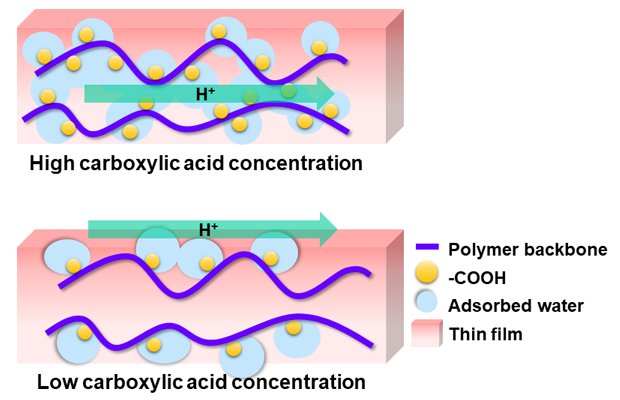Proton's Travel Route in Polymers Could Lead the Way to Clean Fuels
Researchers explore proton transport in thin film polymers containing various concentrations of an organic acid group found in biomaterials
Proton transfer is an essential process for energy conversion in biological systems, but the transfer mechanism is little understood. Now, in a new study, a team of researchers from Japan has investigated the nature of proton transport for various concentrations of a proton-donating group in thin film polymers mimicking a biomaterial, providing important insights about the transport pathways and opening doors to biological technology involving proton conduction and eco-friendly fuel cells.
Protons--subatomic particles with a positive electric charge--are one of the first particles to have formed after the universe began and are a constituent of every atom today out there. The movement of protons plays a key role in energy conversion processes, such as photosynthesis and respiration, in biological systems. In addition, proton conduction is an important factor for hydrogen fuel cells, which are often touted as the ideal clean energy source for the next generation.
High proton conduction observed in biomaterials such as sugar and protein derivatives is attributed to the presence of proton-donating functional groups (substituents in a molecule that governs its characteristic chemical reactions). However, the exact mechanism of proton transport in these materials is not clearly understood (for instance, whether the protons prefer to flow along the biomaterial surface i.e. interfacial transport, or through the bulk). Moreover, it is not clear how the concentration of the functional group might affect proton transport pathway.
Against this backdrop, in a new study recently published in the journal Electrochemistry, a team of researchers from Japan, led by Assoc.Prof. Yuki Nagao from Japan Advanced Institute of Science and Technology (JAIST) and Athchaya Suwansoontorn, a PhD student at JAIST, as well as Assoc.Prof. Katsuhiro Yamamoto from Nagoya Institute of Technology, Prof. Shusaku Nagano from Rikkyo University and Prof. Jun Matsui from Yamagata University, set out to explore how proton conduction was affected in styrene-based polymers with the change in the concentration of carboxylic acid, a proton-donating organic acid found commonly in biomaterials. Suwansoontorn lays out the motivation for their research: "The study of proton transport pathways is fundamentally important to elucidate the functioning of many biological systems."
The research team systematically synthesized polymers with different concentrations of carboxylic acid and prepared them as thin films with high surface-to-bulk ratio to enable investigation of interfacial transport properties. Following this, they characterized the polymer structures using a variety of standard characterization techniques.
The research team observed the presence of two kinds of carboxylic acid groups (COOH) in the polymers: free COOH groups, which were more abundant at higher concentrations, and cyclic dimer COOH groups, which were prevalent at low concentrations. To correlate this with proton transport, the researchers examined in-plane proton conduction using impedance spectroscopy and calculated the interfacial resistance to gauge the possibility of interfacial transport.
They found that a high COOH concentration was more conducive to internal proton transport while lower concentrations favored interfacial transport. They attributed this to the presence of free COOH groups at high concentrations that generated more hydrogen bonding networks, facilitating proton conduction. Furthermore, they verified this idea by showing that a higher number of free COOH groups on the interface led to higher interfacial conduction.
"Our research may contribute to developing bio-conductive materials for biological devices involved with proton conduction and eco-friendly fuel cells," says Suwansoontorn, contemplating the practical ramifications of the findings. "From a broader perspective, it can facilitate people's lives by supporting biological technologies and green energy application development."
To combat climate change, greener energy is the need of the hour. In that context, the findings of this study promise some exciting consequences to look forward to, for sure!
|
Figure 1. Schematic representation of the dependence of the main proton transport pathway in polymer thin films on the carboxylic acid group concentration. |
Reference
| Title of original paper: | Interfacial and internal proton conduction of weak-acid functionalized styrene-based copolymer with various carboxylic acid concentrations |
| Journal: | Electrochemistry |
| DOI: | 10.5796/electrochemistry.21-00042 |
Funding information
This study was funded by research funding from JSPS KAKENHI Grant Number JP18K05257, JP21H00020, and JP21H01997.
May 28, 2021

